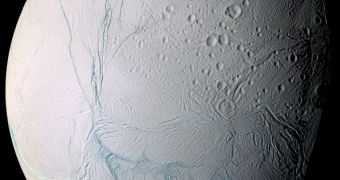Enceladus, the geyser moon of Saturn, will be passed by twice this October, first on the 9th and a second time on the 31st, in an attempt to prove the hypothetical existence of an ocean hiding on its surface.
The first flyby will see Cassini performing the closest such maneuver from the surface of any of Saturn's moons (at just 16 miles, or 25 kilometers), while the second one is going to be at a higher altitude (122 miles, or 196 kilometers). This will help scientists gather data on the possibility that liquid water lies under Enceladus' surface, possibly even forming an ocean. The organic compounds, discovered in a relatively high amount, indicate that there's a noticeable probability of the moon becoming habitable in the future.
“We know that Enceladus produces a few hundred kilograms per second of gas and dust, and that this material is mainly water vapor and water ice,” reveals Cassini scientist Tamas Gambosi from the University of Michigan, Ann Arbor. “The water vapor and the evaporation from the ice grains contribute most of the mass found in Saturn's magnetosphere. One of the overarching scientific puzzles we are trying to understand is what happens to the gas and dust released from Enceladus, including how some of the gas is transformed to ionized plasma and is disseminated throughout the magnetosphere.”
Since 2004, previous Cassini missions helped discover surface traits of Enceladus, like its powerful geysers, which still puzzle the scientists when comparing their might with the moon's dimensions (it has only 310 miles or 500 kilometers), or the temperatures of its tiger stripe-like fractures, like that from the Damascus Sulcus stripe, which is approximately 160 to 167 Kelvin (minus 171 to minus 159 degrees Fahrenheit or -113.15 to -106.15 degree Celsius). Cassini is scheduled for four more Enceladus missions during the next 2 years.

 14 DAY TRIAL //
14 DAY TRIAL //